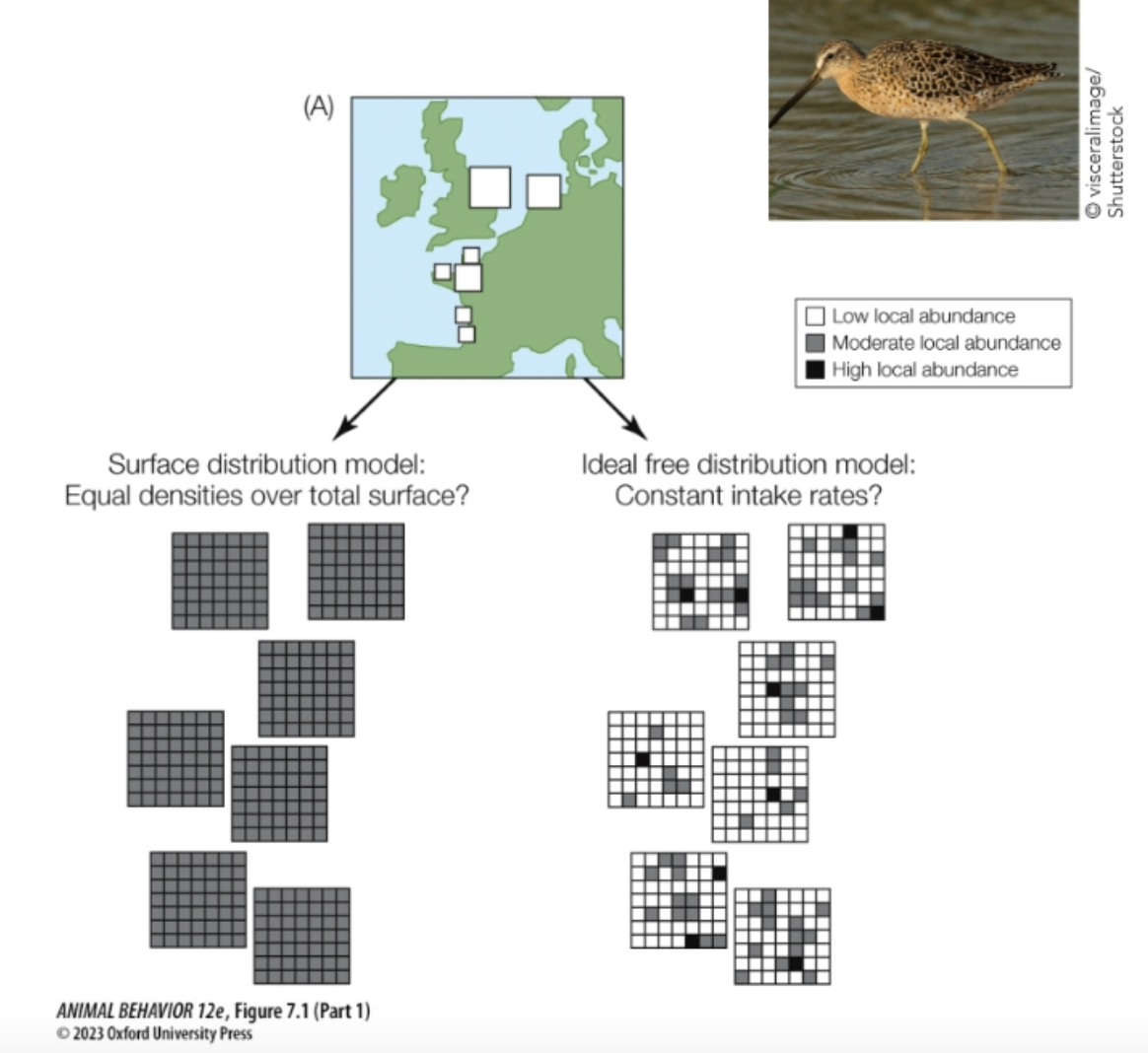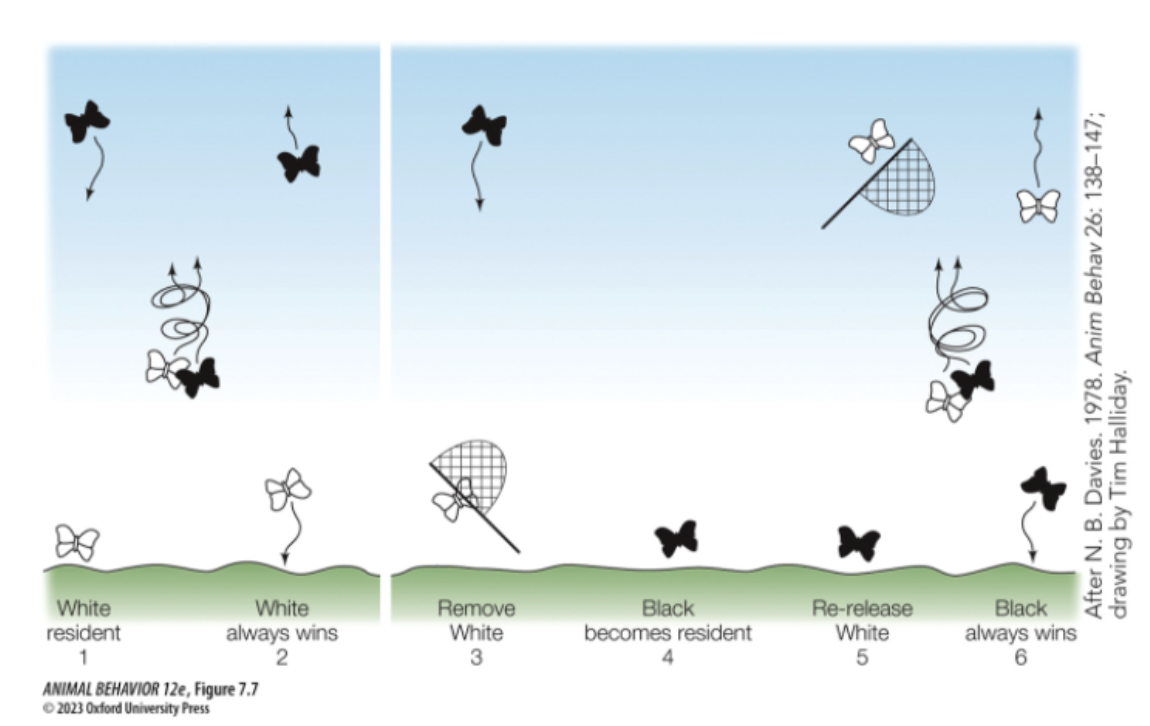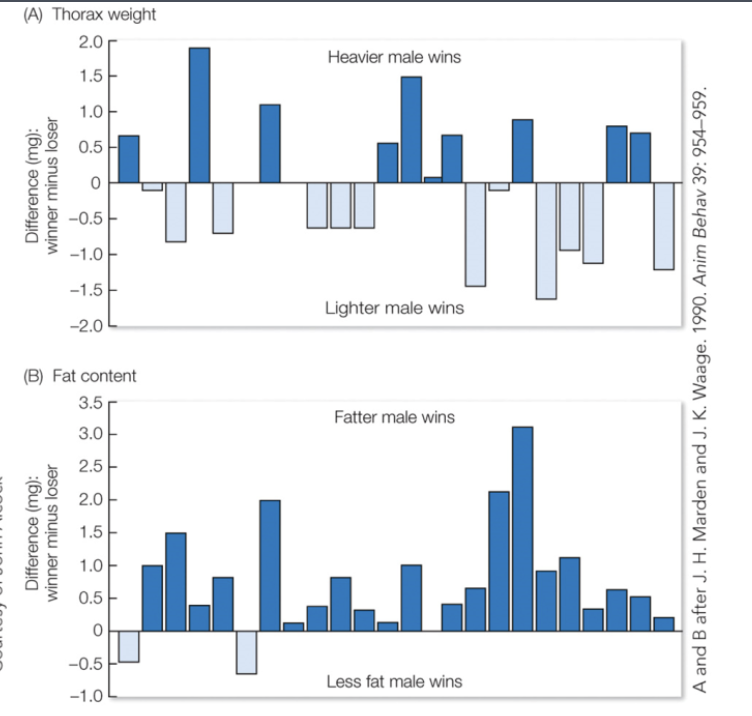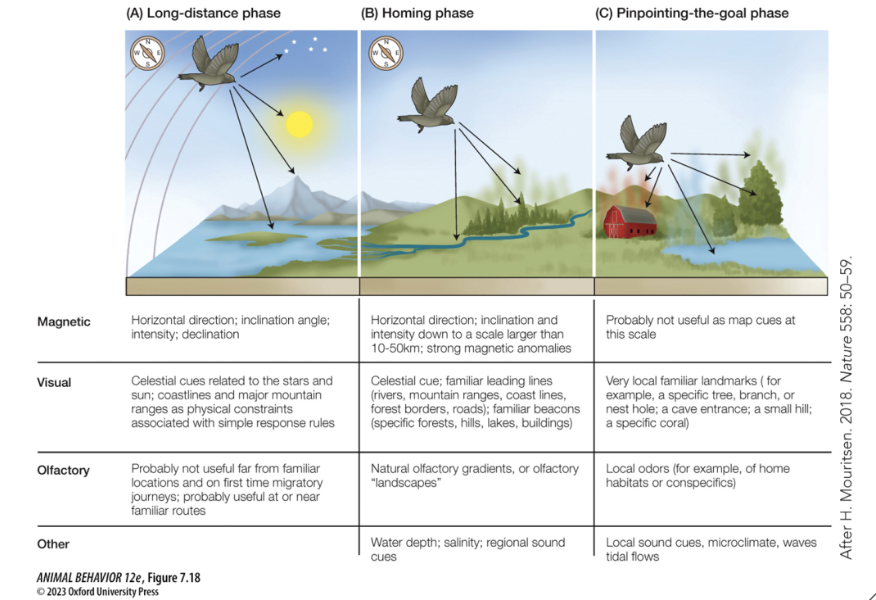Bio465 15 Habitat Selection and Migration
1/21
There's no tags or description
Looks like no tags are added yet.
Name | Mastery | Learn | Test | Matching | Spaced |
|---|
No study sessions yet.
22 Terms
Ideal Free Distribution Theory
-Developed by Fretwell and Lucus using game theory
-Theoretical framework that enables behavioral biologist to predict what animals should do when choosing between alternative habitats of different quality in the face of competition for space, food, or other resources
-If too many individuals are in higher quality patch, a lower quality patch can mathematically become a better location.
-If individuals are free to distribute themselves spatially in relation to both resource quality and intensity of competition
-Then as density of resource consumers increases in high quality habitat, eventually an individual can gain higher fitness by settling for a lower quality habitat

Density Dependent Habitat Selection
Animals make habitat decisions not just on vegetation and resource abundance but also on intensity of intraspecific competition reflected by animals in the location
-Weidinger found that habitat selection was density dependent in backcap warblers
Habitat selection and territory
-Ideal free distribution theory assumes that individuals can freely distribute themselves across their environments
-For territorial animals this is often not possible
-Competing for the best territory becomes the best strategy to maximize fitness
Territory
An area in which individuals exhibit a readiness to defend against intruders and the owner has prioritized access to resources
Territoriality
Economic Defensibility: Describes trade-offs in costs vs benefits access to resources, mates, etc, for maintaining a territory
Ex) Young male collared lizards who inherit territories have more mating opportunities to court female lizards compared to lizards with no territory
Ex) Male chimpanzees patrolling their territory
-This group of males will march along the boundaries of their bands territory where they will attack and even kill members of other groups, the effect of this behavior if successful is the expansion of the attacking bands territory
Hyper-territorial males used up their energy reserves and died sooner than males with normal concentration of testosterone
-When given a food supplement, the hyper territorial male survived as well or better than the controls
-High energetic cost
-Because territoriality is so costly, peaceful coexistence should be the norm when the benefits of owning a resource do not outweigh the costs of monopolizing it
-We see this in several species that are not territorial in the non-breeding season, but then become highly aggressive when competing for access for mates during breeding
Resource-Holding drive
The ability of a territorial animal to win a fight when competing for useful resources
Costs and Benefits of Territoriality
-The American redstart competes for territory in the non-breeding season while down south
-Differences in the quality of wintering habitat not only affect body condition, but also the length of bird’s telomeres
-The ability to hold territories on high quality habitat led to healthier birds that were better equipped to reach the breeding grounds first and gain a reproductive advantage
Competition for Territories
Why do intruders often give up so quickly if there is a strong fitness benefit to acquiring a territory
-Arbitrary contest resolution hypothesis
The resident always wins territorial battles
-Resource-holding potential hypothesis
Residents have an edge in physical combat
-Payoff Asymmetry hypothesis
Residents place a higher value on a territory than do rivals
Arbitrary contest resolution hypothesis
Ex) Is there any methodology that influenced butterfly behavior (and ultimately biased their results)

Resource-Holding Potential

Payoff Asymmetry Hypothesis
-Residents place higher value on a territory than do rivals
-Predicts that contests between an ex-resident and his replacement will become more intense as the tenure of the replacement increases
-Motivation to defend territory increases with duration on territory
Ex) If you remove a tarantula hawk wasp from its territory a new male will quickly replace him. If you release him within 3 minutes, he will promptly chase the newcomer off. However, if you hold him for longer before releasing him, the new male is more likely to defend the newly acquired territory, and a battle will ensue between the two males.
The dear enemy effect
Territorial animals are less aggressive towards neighbors than they are towards strangers
Stephan’s Kangaroo Rat
-Attempts to establish new breeding populations in California failed
-Released rats in groups of familiar enemies and unfamiliar pairs
-Groups of “dear enemies” fought less and produced more offspring
To stay or go
-Occur at different stages of an animal’s life
-Occur at different scales of movement
-Some animals will do neither
Dispersal
The permanent movement of an animal from its birthplace to another location
-One way, permanent movement from birthplace to somewhere else
-Can carry cost
Sex Biased Dispersal: One sex disperses further than the rest
Why have it? Inbreeding Hypothesis
-In the context of dispersal, sex biased dispersal reduces the chance of inbreeding
-Inbreeding often negatively affects fitness
-Female hyenas typically avoid males that were born in their clan, making it adaptive for these males to leave to search for unrelated females elsewhere

Migration
Relatively long-distance movement that involves a departure and then return to a particular location on an annual or seasonal basis
-Birds, mammals, amphibians, fish, insects, zooplankton
Active Dispersal
One-way permanent movement of an organism through its own ability from the place it was born to another location
Passive Dispersal
An organism cannot move on its own from the place it was born to another location and must instead rely on forces like wind or water currents
-Ballooning in spiders that use electrostatic currents
Costs and Benefits of Migration
Costs
-Energetically expensive
-Have to secure extra energy reserves
-Risk of death (predation, exposure)
Benefits
-More food, less consumption
-Less harsh climates
-Other resources
Drivers
-Bottom Up Forces: When food and other resources influence migration
-Top Down Forces: When predation risk influences migration
Migration (red knots)
-Weight 110 grams
-Add more than 70 grams at stopover point on the way to artic breeding grounds
-Feed on horseshoe crab eggs
-Over harvesting of horseshoe crabs in bay decreased this population by 75%
Tinbergen’s 4 Questions of Migration
What mechanism causes migration
-Day length→ hormonal changes
How does it develop
-Can be learned and innate
What is the adaptive function of the behavior
-Track resources→ fitness benefits
How did the behavior evolve
-Changing seasonal resource availability
Mechanisms of Migration
Determining Direction
-Orientation
Determination and maintenance a proper direction
-Navigation
Determining a particular location and moving towards it
-Sun Compass
Use of sun for orientation
-Star Compass
Use of stars or constellations
-Geomagnetic Compass
Ability to orient using the earth magnetic field
Some birds, sea turtles, fish, and amphibians

How did migration behavior evolve (hypothesis)
-Tropical origins hypothesis
Migration evolved through a geographic shift from the tropics to the temperate breeding grounds to take advantage of the rich bounty of food resources for reproduction
-Temperate origins hypothesis
Migration evolved through a shift towards the tropical wintering grounds from the temperate breeding grounds to take advantage of the milder climate during non breeding season